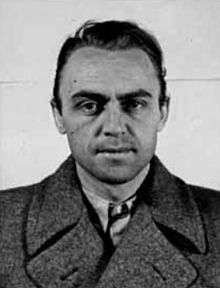Alfred Naujocks

Alfred Helmut Naujocks, alias Hans Müller, Alfred Bonsen, or Rudolf Möbert (20 September 1911 – 4 April 1966), was an SS-Sturmbannführer (major), and took part in a staged incident intended to provide the justification for the attack on Poland by Nazi Germany, which in turn provoked the Second World War in Europe.
Early life
Naujocks was born in Kiel and attended the University of Kiel[1] where he studied engineering and, after an incomplete apprenticeship as a precision mechanic, he joined the SS in 1931.[2] He then signed on a driver for the SD-Regional Command East, Berlin.[3] He led an undercover attack on an Anti-Nazi radio station in the village of Záhoří, near Slapy, Prague, Czechoslovakia on 23 January 1935. Black Front activist Rudolf Formis was killed in the incident;[4] He confessed to the murder in 1944 while in American custody.[5] By autumn 1937, Naujocks was promoted to Hauptsturmführer (captain) and by 1938 was promoted again to Sturmbannführer (major).[3]
World War II
On 10 August 1939, Reinhard Heydrich directed Naujocks of his mission to lead a small group of German operatives to seize the Gleiwitz radio station.[6] Thereafter, on the night of 31 August, Naujocks led the attack on the German radio station Gleiwitz, one of twenty-one similar concentrated attacks that the Germans quickly attributed to the Polish. Once inside the radio station, a short broadcast of a anti-German message in Polish was made (although sources vary on the content of the message). Shots were then fired in the studio and a corpse left on the floor near the microphone.[7]
To add documented proof of this attack, the SD operatives placed fictitious Polish troops (corpses of prisoners from the Dachau concentration camp who had been dressed in Polish uniforms provided by the Abwehr, killed by lethal injection, and then shot for appearance) around the 'attacked' radio station for selected members of the press to see at the site of the incident.[8] These attacks, but not exclusively the Gleiwitz incident, formed Hitler's justification to the Reichstag regarding the necessary "pacification" of Poland, thereby setting Second World War in Europe into motion.[9]
More recently, in his investigation the author and researcher Jak Mallmann-Showell has suggested that Naujocks' claims as to his actions at the Gleiwitz radio station may have been a fabrication to curry special handling by the Allies after the war. Mallmann-Showell has discerned that Naujocks is the one source for the details of his personal actions on the night of 31 August 1939. He also avers that the Poles may have accessed the site to obtain Enigma machine secrets for the allies.[10]
Later, on 9 November, Naujocks (along with Walter Schellenberg) participated in the Venlo incident, which saw the capture of two British SIS agents, Captain Sigismund Payne Best and Major Richard Henry Stevens in the Netherlands.
In 1941, he was dismissed from the SD after disputing one of Reinhard Heydrich's orders. He was demoted and had to serve in the Waffen-SS on the Eastern Front. In 1943, due to his health, he was sent to the West, where he served as an economic administrator for the troops in Belgium, while involving himself in the deaths of several Belgian Underground members.
After his promotion to Obersturmführer (first lieutenant) he participated in sabotage and terrorist actions against the Danish population from December 1943 until autumn 1944, as the leader of the "Peter Group", including the murder of a Lutheran pastor Kaj Munk.[11] Later leadership passed to SS-Hauptsturmführer Otto Alexander Friedrich Schwerdt (SS-Jagdverbände). Circa November 1944, Naujocks turned himself over to American forces, who subsequently placed him in detention as a possible war criminal.
After the war
At the Nuremberg Trials, Naujocks declared the attack against German Radio Tower in Gleiwitz was under orders from Heinrich Müller, the head of Gestapo and his superior, Reinhard Heydrich. After the war, having escaped from custody, he worked as a businessman in Hamburg, where he also sold his story to the media as The Man who Started the War.
Death
Naujocks died of a heart attack in Hamburg on 4 April 1966, aged 54.[12]
See also
Notes
- ↑ Shirer, William L. (1960). The Rise and Fall of the Third Reich. New York: Simon and Schuster. pp. 518–519. LCCN 60-6729.
- ↑ Weale 2010, p. 137.
- 1 2 Weale 2010, p. 138.
- ↑ Klimek, Antonín (2003). Vítejte v první republice. Praha: Havran. pp. 251–253. ISBN 80-86515-33-8.
- ↑ Alfred Naujocks: Eine verflixt heikle Geschichte (in German)
- ↑ Weale 2010, p. 139.
- ↑ Aisby 2001, p. 112.
- ↑ Shirer (1990). The Rise and Fall of the Third Reich, pp. 518-520.
- ↑ Benz (2007). A Concise History of the Third Reich, p. 170.
- ↑ Mallmann-Showell, Jak P. (2009), Enigma U-Boats; Breaking the Code, Annapolis, MD: Naval Institute Press, ISBN 978-1-59114-238-6
- ↑ Murder of Kaj Munk, findagrave.com; accessed 22 January 2015.
- ↑ Stalin enthauptet die Rote Armee: Der Fall Tuchatschewskij (in German)
References
- Ailsby, Christopher (2001). The Third Reich Day by Day. Zenith Imprint. ISBN 0-7603-1167-6.
- Benz, Wolfgang (2007). A Concise History of the Third Reich. Berkeley, CA: University of California Press. ISBN 978-0-52025-383-4
- Mallmann Showell, Jak P. (2009). Enigma U-Boats, revised edition, page 166.
- Shirer, William L. 1990 [1959]. The Rise and Fall of the Third Reich. New York: MJF Books. ISBN 978-0-83177-404-2
- Weale, Adrian (2010). The SS: A New History. London: Little, Brown. ISBN 978-1408703045.
| Wikimedia Commons has media related to Alfred Naujocks. |
|